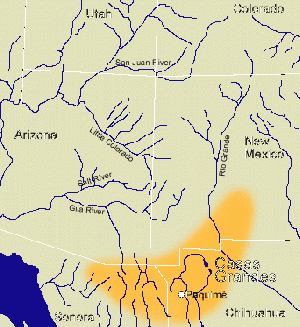Casas Grandes
Characteristics
The people of Casas Grandes seem to have been more closely affiliated with the Mesoamerican peoples to the south than the Mogollon or Hohokam to the north. Platform mounds and ballcourts for ritual activities are characteristic features of Central American cultures at this time. Family groups lived along the river drainages, and developed extensive irrigation systems. The town of Paquimé was a major trading center, through which such luxury items as shells, copper, macaws and pottery made their way into Arizona and New Mexico from Central America.
House Types
Early Casas Grandes sites consist of groups of shallow pithouses arranged around a larger community house. Square contiguous surface rooms followed at a later period. The pithouses and surface rooms were constructed of an advnced form of jacal, a type of wattle-and-daub construction. The plaza grouping became more prevalent and probably housed lineages, groups of people with common ancestors. Ultimately, a form of poured adobe walls was developed.
Pottery
Early Casas Grandes pottery was similar to the red and brown wares of the Mogollon. These are often decorated with red geometric designs, usually banded. Later, distinctive polychrome varieties appeared, perhaps under the influence of West Mexican Nayarit or Jalisco pottery.
